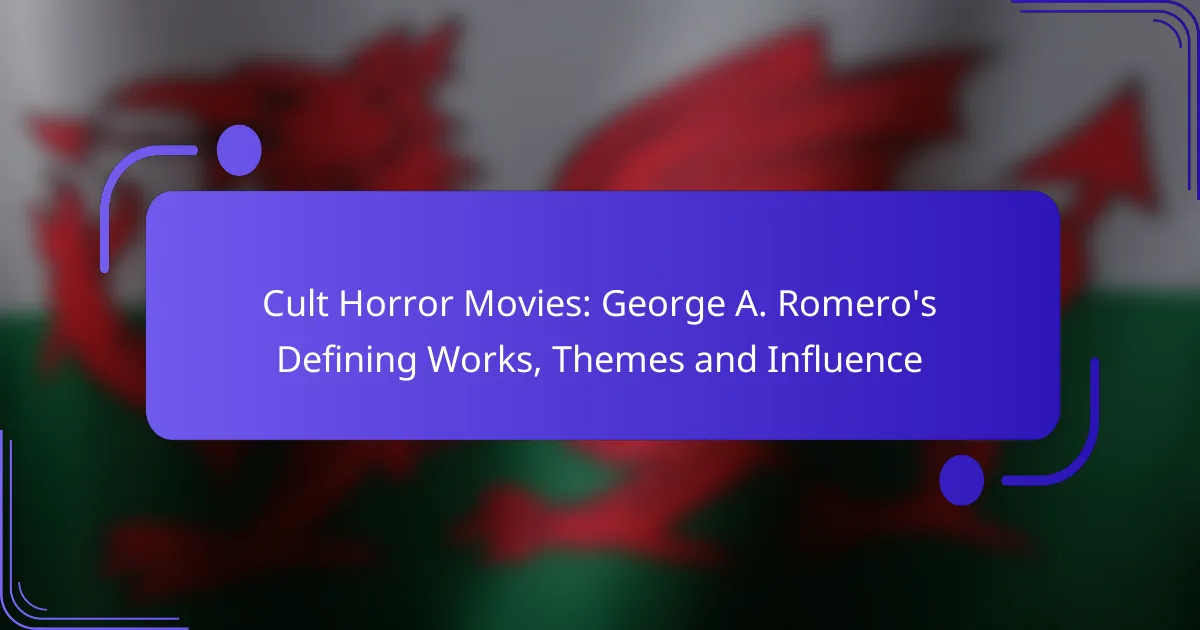George A. Romero is a pivotal figure in horror cinema, best known for his revolutionary zombie films that not only shaped the genre but also provided sharp social commentary. His innovative storytelling transformed zombies into symbols of societal fears, addressing themes like consumerism, isolation, and human nature. Through his work, Romero engaged audiences with narratives that critique contemporary culture while redefining horror’s role in film.
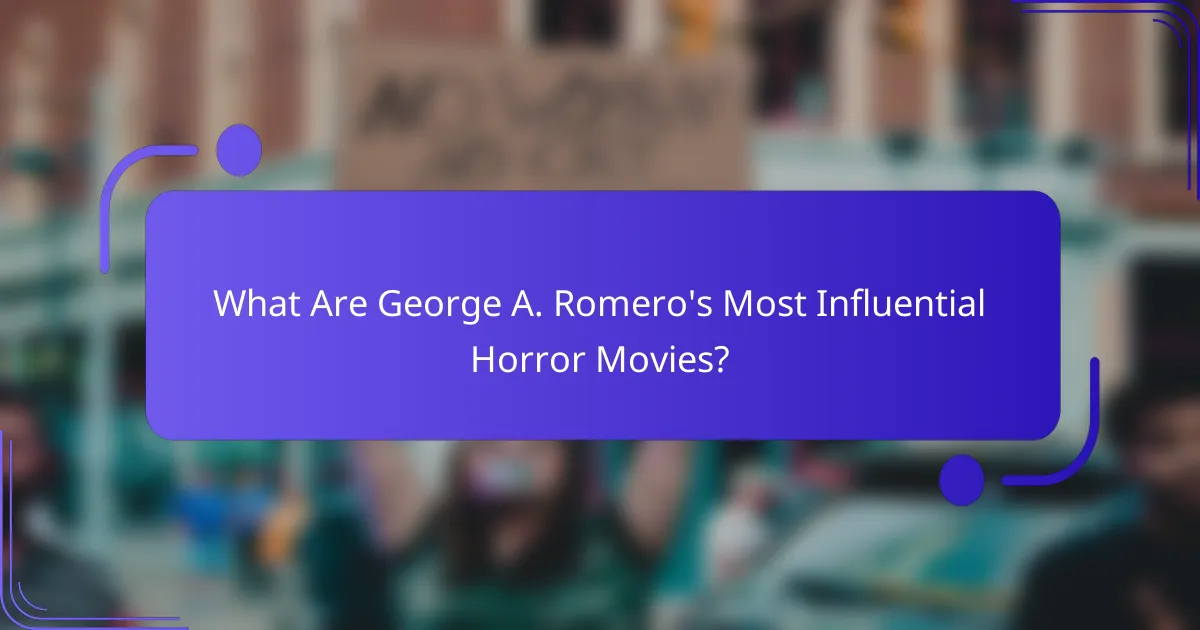
You can explore more about his impact on the genre on our homepage.
What Are George A. Romero’s Most Influential Horror Movies?
George A. Romero is renowned for his groundbreaking contributions to the horror genre, particularly through his zombie films. His works not only defined the zombie apocalypse narrative but also explored social commentary, making them influential in both cinema and culture.
Night of the Living Dead
Released in 1968, “Night of the Living Dead” is often credited with launching the modern zombie genre. The film’s portrayal of a group of survivors trapped in a farmhouse while the dead rise to consume the living set a new standard for horror storytelling.
This film is notable for its stark social commentary, addressing issues such as race and societal breakdown during a time of significant social upheaval in the United States. Its low-budget production and innovative use of black-and-white cinematography contributed to its lasting impact.
Dawn of the Dead
“Dawn of the Dead,” released in 1978, expanded on the themes of its predecessor while introducing a satirical edge. Set in a shopping mall, the film critiques consumerism and the human condition amidst a zombie apocalypse.
The film’s blend of horror and dark humor, along with its graphic special effects, established it as a classic. It also introduced the concept of the “fast zombie,” which has influenced many subsequent horror films.
Day of the Dead
In 1985, “Day of the Dead” continued Romero’s exploration of societal collapse, focusing on a group of military personnel and scientists in an underground bunker. This installment delves deeper into themes of survival, control, and the psychological effects of isolation.
The film is notable for its more developed characters and philosophical discussions about humanity’s future. Its special effects, created by Tom Savini, pushed the boundaries of gore in film, making it a significant entry in the horror genre.
Land of the Dead
“Land of the Dead,” released in 2005, marked Romero’s return to the zombie genre after a long hiatus. Set in a post-apocalyptic world where the living have retreated to fortified cities, the film addresses class struggles and societal division.
This film features a more sophisticated approach to the zombie narrative, with the undead exhibiting signs of intelligence and organization. Its commentary on social inequality remains relevant, making it a poignant addition to Romero’s oeuvre.
Survival of the Dead
Released in 2009, “Survival of the Dead” explores the conflict between two families on a remote island as they deal with the zombie outbreak. The film reflects on themes of tradition versus progress and the moral dilemmas faced in a world overrun by the undead.
While it received mixed reviews, the film continues Romero’s legacy of blending horror with social issues. It serves as a reminder of the enduring nature of his themes and the ongoing relevance of his work in contemporary horror cinema.
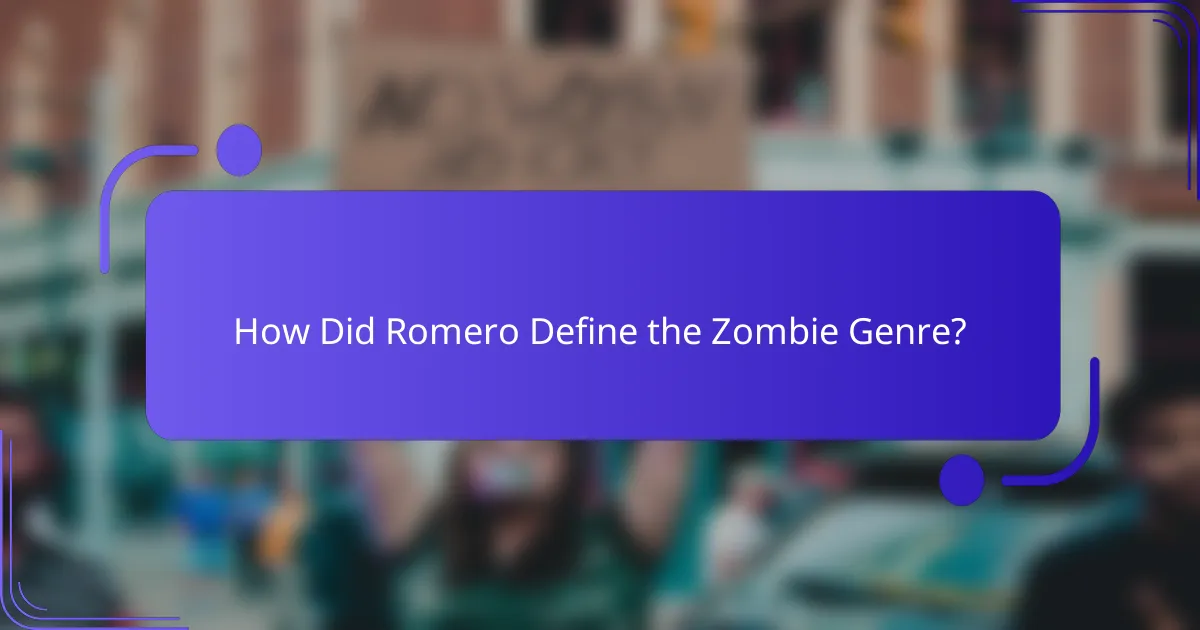
How Did Romero Define the Zombie Genre?
George A. Romero is credited with defining the zombie genre through his innovative storytelling, which combines horror with social critique. His films introduced the concept of zombies as a reflection of societal issues, transforming them from mere monsters into symbols of deeper human fears and conflicts.
Social Commentary
Romero’s films often serve as a mirror to society, addressing themes such as consumerism, racism, and the breakdown of social order. For instance, “Night of the Living Dead” critiques racial tensions in America during the 1960s, while “Dawn of the Dead” highlights the mindless consumption prevalent in modern culture. This layer of social commentary elevates his work beyond traditional horror, prompting audiences to reflect on their realities.
By embedding these themes within the horror genre, Romero encouraged viewers to engage with uncomfortable truths about society. His use of zombies as a metaphor for societal decay resonates with audiences, making his films both entertaining and thought-provoking.
Character Development
Romero’s approach to character development is integral to his storytelling. He often focuses on ordinary people facing extraordinary circumstances, allowing viewers to connect with them on a personal level. Characters in his films, such as Ben in “Night of the Living Dead,” are multi-dimensional, showcasing a range of emotions and moral dilemmas as they navigate the chaos of a zombie apocalypse.
This depth of character adds emotional weight to the narrative, making the horror more impactful. Audiences are not just scared by the zombies; they are invested in the characters’ survival and moral choices, which enhances the overall experience of the film.
Innovative Filmmaking Techniques
Romero revolutionized the horror genre with his innovative filmmaking techniques, including the use of practical effects and groundbreaking makeup. His work in “Dawn of the Dead” showcased realistic gore and special effects that set a new standard for horror films. The visceral nature of these effects heightened the sense of fear and realism, drawing audiences deeper into the narrative.
Additionally, Romero’s use of handheld cameras and natural lighting created an immersive atmosphere that made viewers feel like they were part of the unfolding chaos. This raw, documentary-style approach contributed to the authenticity of his films, influencing countless filmmakers in the horror genre and beyond.
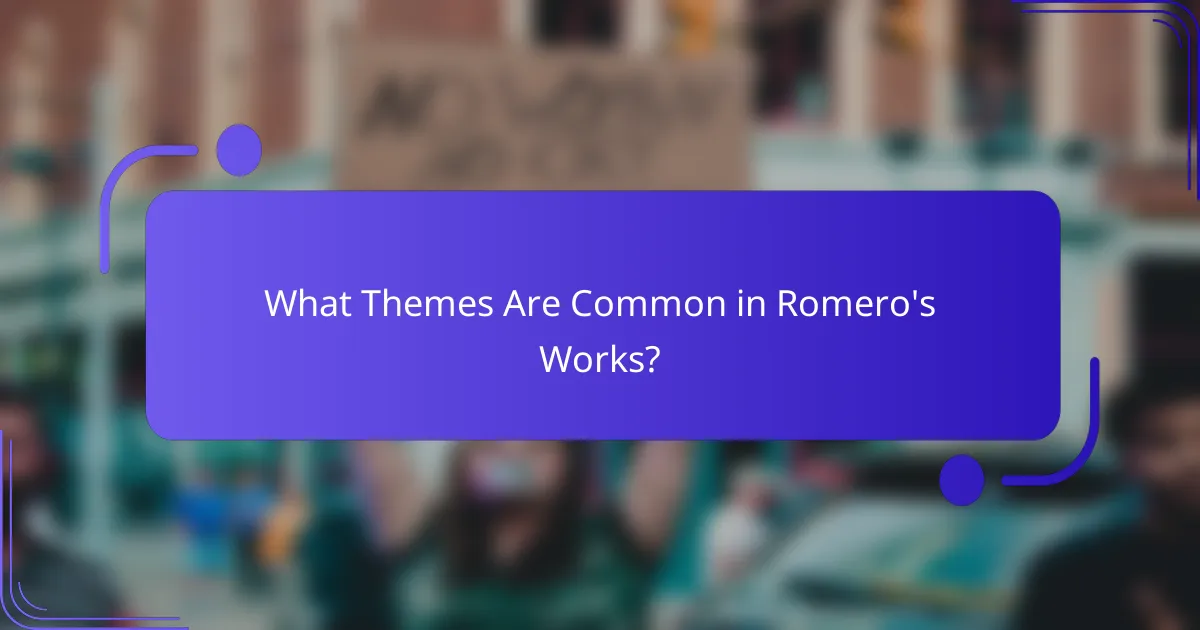
What Themes Are Common in Romero’s Works?
George A. Romero’s films often explore themes such as consumerism, isolation, and human nature, reflecting societal issues and human behavior in times of crisis. These recurring motifs serve to critique contemporary culture while engaging audiences with thought-provoking narratives.
Consumerism
Romero frequently critiques consumerism, illustrating how societal obsession with material goods can lead to moral decay. In films like “Dawn of the Dead,” the mall setting becomes a symbol of excess, where the characters’ survival is juxtaposed against the backdrop of mindless shopping.
This theme resonates with viewers, prompting them to reflect on their own consumption habits. Romero’s portrayal of zombies as mindless consumers serves as a stark warning about the dangers of prioritizing possessions over human connections.
Isolation
Isolation is another prevalent theme in Romero’s works, often depicted through characters cut off from society. This sense of separation amplifies the psychological tension, as individuals confront their fears and vulnerabilities when faced with the undead.
In “Night of the Living Dead,” the characters’ isolation in a farmhouse highlights their struggle for survival and the breakdown of social order. This theme emphasizes the fragility of community and the human instinct to seek connection, even in dire circumstances.
Human Nature
Romero’s exploration of human nature reveals the complexities of morality and ethics during crises. His characters often face difficult choices that test their values, showcasing both altruism and selfishness in extreme situations.
For instance, in “Day of the Dead,” the conflict between the military and scientists illustrates the struggle between survival instincts and the desire for cooperation. Romero’s nuanced portrayal of human nature invites viewers to consider how they might react when confronted with similar challenges.
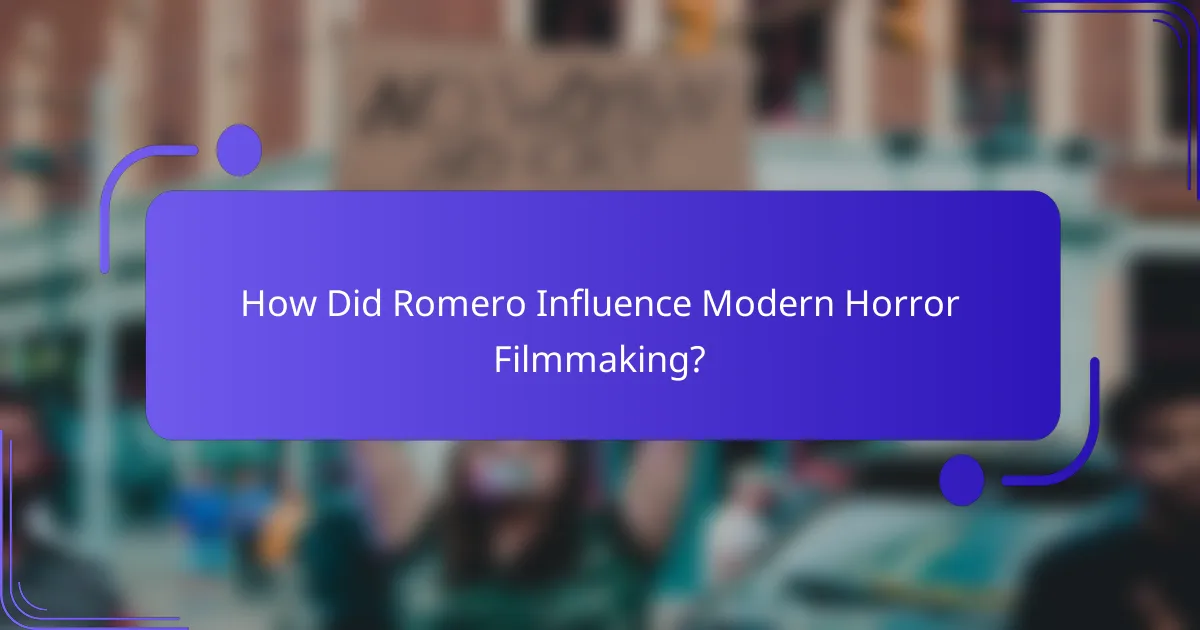
How Did Romero Influence Modern Horror Filmmaking?
George A. Romero profoundly influenced modern horror filmmaking by redefining the genre through his innovative storytelling and social commentary. His unique approach to horror, particularly in the zombie subgenre, has inspired countless filmmakers to explore deeper themes and character development.
Impact on Filmmakers
Romero’s work has served as a blueprint for many contemporary horror directors. Filmmakers like Zack Snyder and Edgar Wright have cited Romero’s ability to blend horror with social critique as a major influence on their own films. This legacy encourages new directors to push boundaries and incorporate relevant societal issues into their narratives.
Moreover, Romero’s emphasis on character-driven stories over mere shock value has led to a more thoughtful approach in modern horror. This shift has resulted in films that resonate on emotional and psychological levels, allowing audiences to connect with characters in ways that traditional horror often overlooked.
Revival of Zombie Genre
Romero is credited with revitalizing the zombie genre, particularly with his film “Night of the Living Dead.” This film not only established the rules of zombie lore but also introduced the concept of zombies as a reflection of societal fears. His influence is evident in the resurgence of zombie-themed media, including films, television series, and video games.
Today, franchises like “The Walking Dead” and films such as “World War Z” continue to draw from Romero’s foundational work. These adaptations often explore themes of survival, morality, and the human condition, echoing the complexities Romero introduced to the genre.
Cultural References
Romero’s impact extends beyond cinema into popular culture, where his films are frequently referenced in various media. Phrases like “zombie apocalypse” and tropes such as the “survivor group” have become ingrained in the cultural lexicon, showcasing the lasting relevance of his work.
Additionally, Romero’s films have inspired numerous parodies and homages across genres, from comedy to action. This cross-pollination highlights how his storytelling techniques and thematic explorations have permeated different facets of entertainment, solidifying his status as a cultural icon in horror filmmaking.
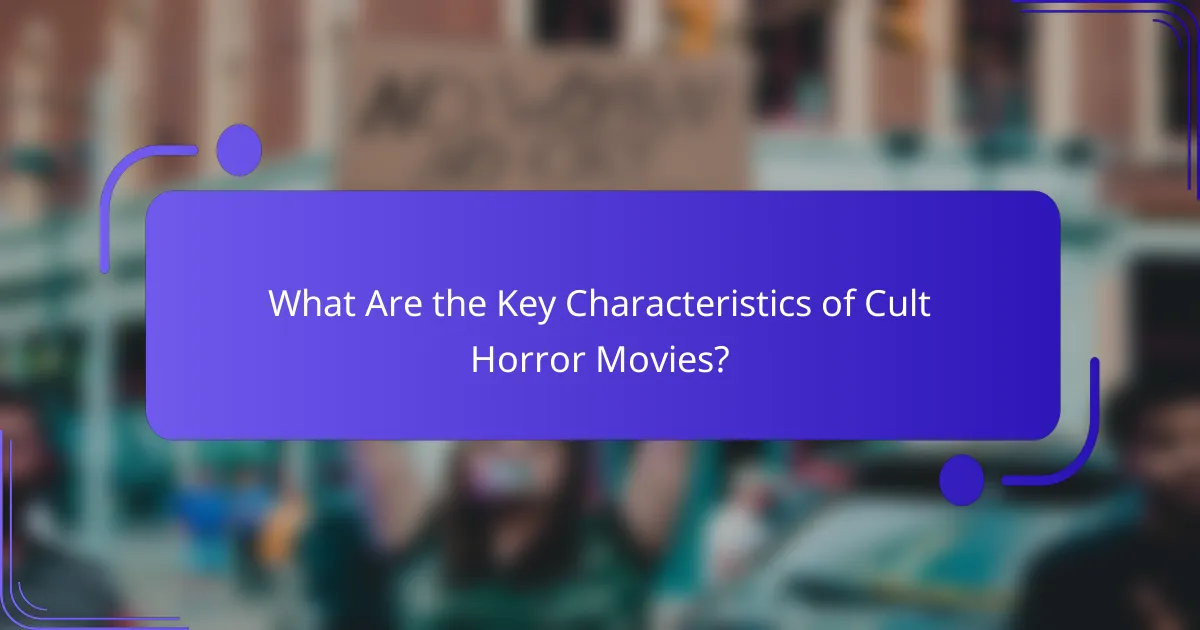
What Are the Key Characteristics of Cult Horror Movies?
Cult horror movies are defined by their unique blend of unconventional storytelling, dedicated fanbases, and often subversive themes. These films typically challenge mainstream norms and resonate deeply with audiences, creating a lasting impact beyond their initial release.
You can explore the works of influential filmmakers in iconic directors of cult horror.
Fan Engagement
Fan engagement in cult horror films is characterized by strong community involvement and passionate discussions. Fans often gather at conventions, participate in online forums, and create fan art or fan fiction, which enhances their connection to the films.
Many cult horror movies encourage this engagement through interactive experiences, such as screenings with Q&A sessions, where fans can interact with filmmakers and actors. This direct interaction fosters a sense of belonging and loyalty among viewers.
Subversive Elements
Subversive elements in cult horror movies often include themes that challenge societal norms, such as critiques of consumerism, authority, or traditional morality. These films frequently employ shock value, dark humor, and unexpected plot twists to provoke thought and discussion.
Examples of subversive themes can be seen in George A. Romero’s works, where zombies often symbolize societal decay or the consequences of human behavior. This layer of meaning invites viewers to reflect on real-world issues, making the films resonate on a deeper level.
